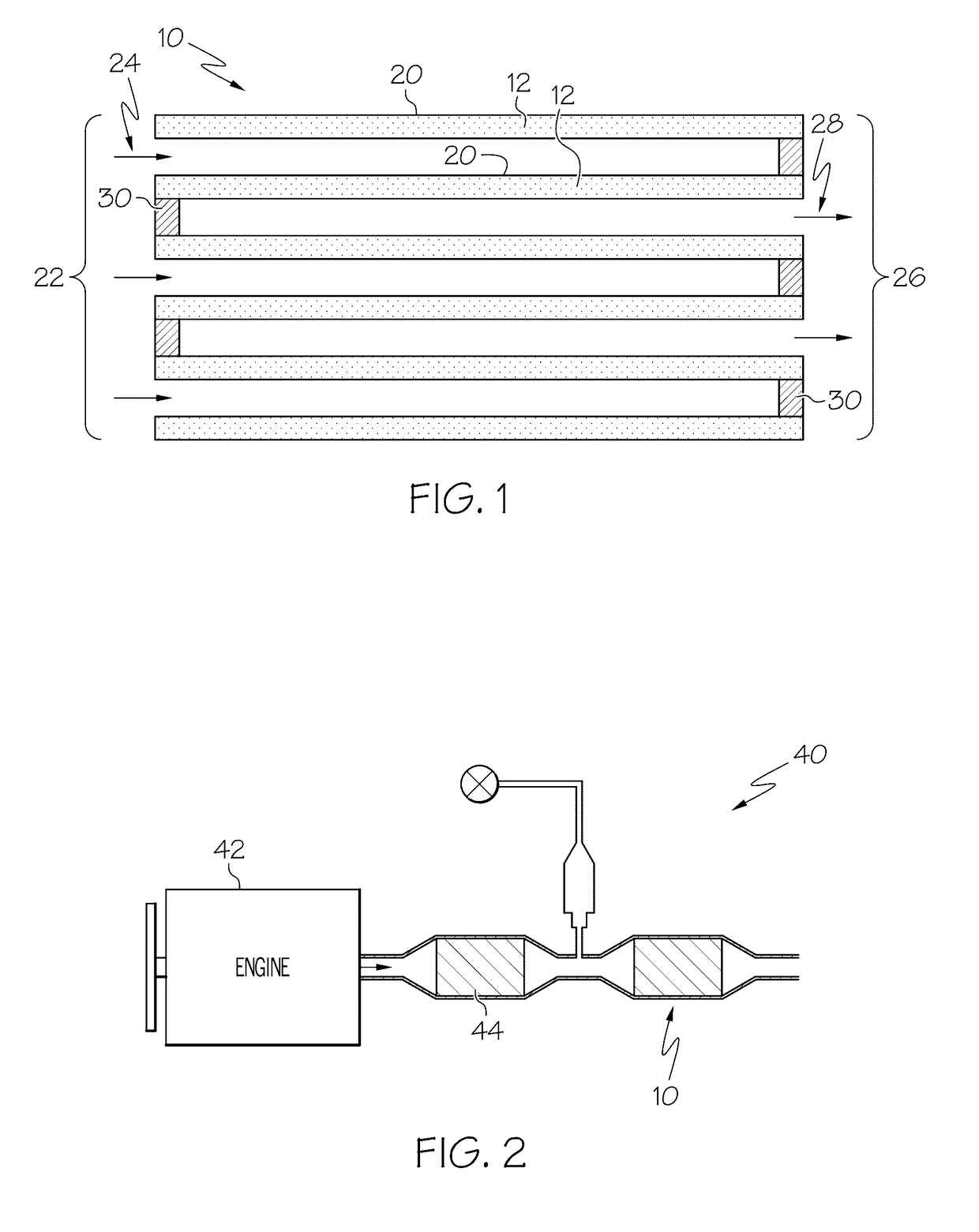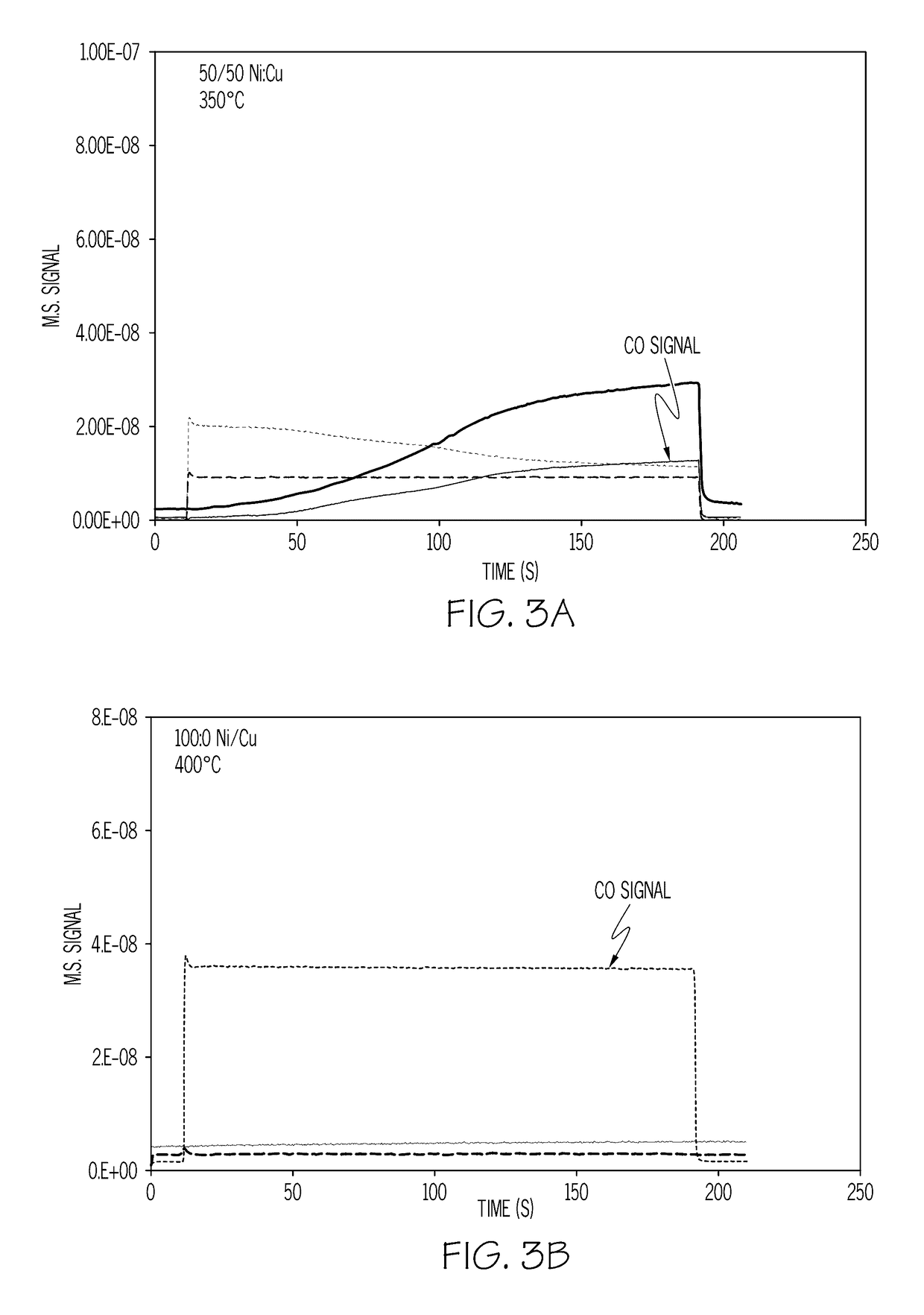Particulate filter containing a nickel-copper catalyst
a technology of catalyst and catalyst, which is applied in the direction of physical/chemical process catalyst, metal/metal-oxide/metal-hydroxide catalyst, etc., can solve the problems of unsatisfactory back pressure to the engine, the cost of catalytic soot filter production is typically high, and the commercial filter currently in use is ineffective at burning the deposited particulates at the temperature encountered under normal operating conditions, etc., to achieve the effect of improving the rate of oxidation of co, the reduction of nitrogen oxid
- Summary
- Abstract
- Description
- Claims
- Application Information
AI Technical Summary
Benefits of technology
Problems solved by technology
Method used
Image
Examples
example 1
[0046]A catalyst sample loaded with 11 wt % of a nickel-copper mixture at a 1:1 Ni:Cu weight ratio was exposed to a simulated exhaust gas containing 1% CO in 10% H2O / N2 (volume %). As shown in FIG. 3A, the CO was completely removed at 350° C. A catalyst sample loaded with 12 wt % nickel (no copper) showed no CO conversion even at 400° C. under the same conditions as shown in FIG. 3B. As can be seen, the nickel-copper catalyst operates at lower temperatures and shows a greater rate of reduction / oxidation, which also indicates a greater OSC value.
example 2
[0047]A filter substrate comprised of cordierite in a column sized at 3 inches in length and 1 inch in diameter was dipped into a 6.50 ml well-mixed solution of nickel and copper. The concentration of nickel was 2.51×10−2 g. per gram solution and the concentration of copper was also 2.51×10−2 g. per gram solution. After dipping, the filter substrate was turned upside down and dipped into a 6.0 ml well-mixed solution of nickel and copper with the same concentrations described above. After soaking up the solution, the filter substrate was placed into an oven at 150° C. for 30 minutes. The dried filter was then calcined in a furnace at 600° C. for 1 hour. The resulting filter (Filter A) contained 5.3 wt % nickel-copper having a Ni:Cu weight ratio of 1:1.
example 3
[0048]A filter substrate comprised of cordierite in a column sized at 3 inches long and 1 inch diameter was dipped into a 6.50 ml solution of well mixed nickel and copper. The concentration of copper was 5.505×10−2 g. nickel per gram solution and 5.499×10−2 g copper per gram solution. After dipping, the wetted filter was inserted into a flow of 5 liter air per minute at 225° C. for 20 minutes. After this drying process, the other end of the filter was dipped into a 6.00 ml solution containing well mixed 5.505×10−2 g. nickel and 5.499×10−2 g copper per gram solution. The wetted filter was again inserted into a flow of 5 liter air per minute at 225° C. for 20 minutes. The dried sample was heated in air at a rate of 5° C. / min. to 600° C. then held at 600° C. for 1 hour. The resulting filter (Ni—Cu Filter) contained 10.3 wt % of nickel-copper having a weight ratio of 1:1.
[0049]FIG. 4 illustrates the oxygen-storage-capacity (OSC) of the Ni—Cu Filter in comparison with filters containing ...
PUM
| Property | Measurement | Unit |
|---|---|---|
| temperature | aaaaa | aaaaa |
| temperature | aaaaa | aaaaa |
| temperature | aaaaa | aaaaa |
Abstract
Description
Claims
Application Information
 Login to View More
Login to View More - R&D
- Intellectual Property
- Life Sciences
- Materials
- Tech Scout
- Unparalleled Data Quality
- Higher Quality Content
- 60% Fewer Hallucinations
Browse by: Latest US Patents, China's latest patents, Technical Efficacy Thesaurus, Application Domain, Technology Topic, Popular Technical Reports.
© 2025 PatSnap. All rights reserved.Legal|Privacy policy|Modern Slavery Act Transparency Statement|Sitemap|About US| Contact US: help@patsnap.com



